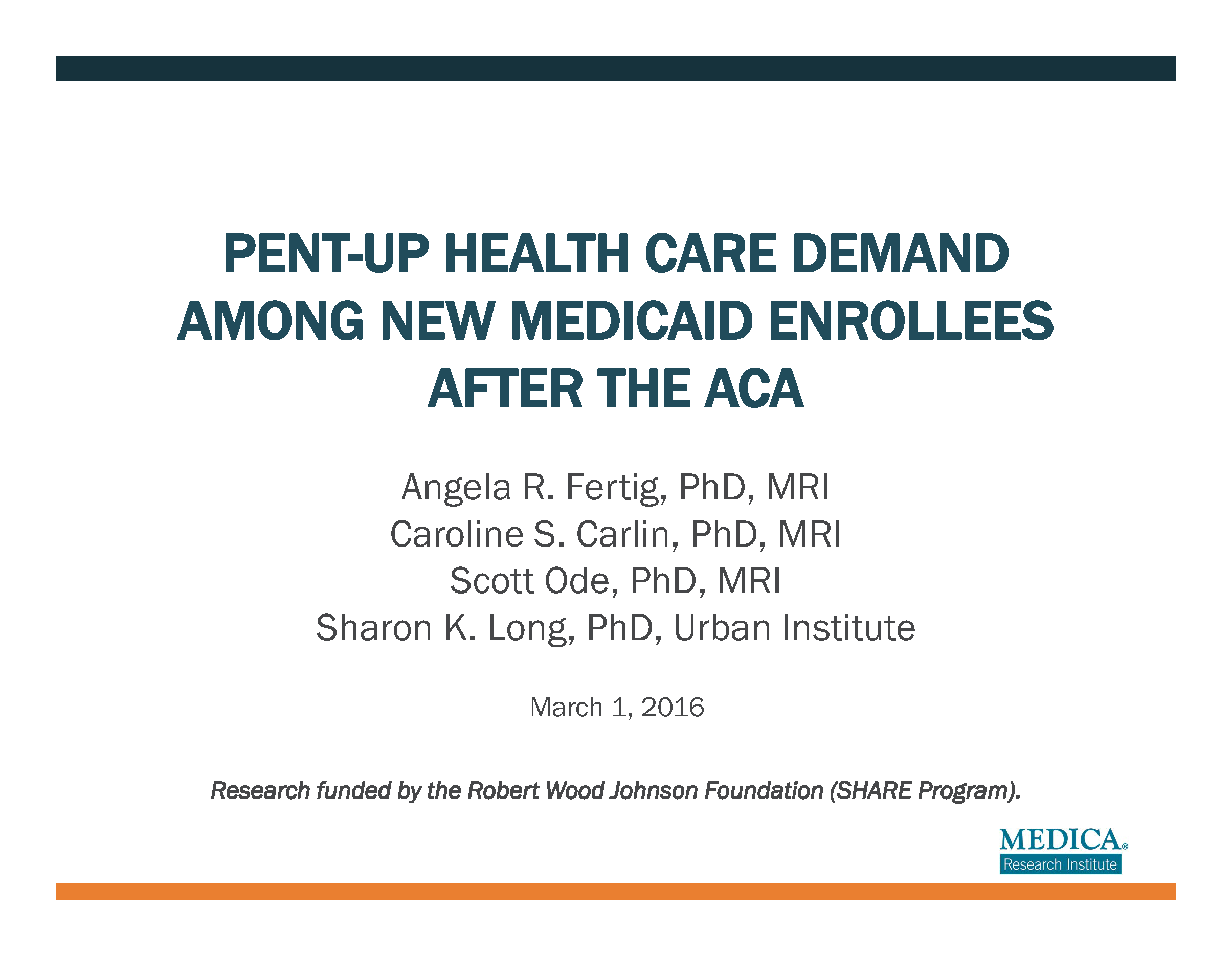Publication
Using HCUP Data for State Health Policy Analysis: A Case Study Examining the Impacts of an Early Medicaid Expansion
This brief from the SHARE grant program examines a rich source of US hospital administrative data--the Healthcare Cost and Utilization Project (HCUP)--and provides an example of how a SHARE-funded research project led by Dr. Peter Cunningham at Virginia Commonwealth University has used these data to evaluate the impacts of an early ACA Medicaid expansion on utilization-related outcomes at hospitals in California.
Blog & News
SHADAC at the Minnesota Health Services Research Conference
March 7, 2016:The 2016 Minnesota Health Services Research Conference took place last week in St. Paul, MN, with the goal of showcasing innovative research across public, private, and academic arenas. We are pleased to highlight several SHADAC-sponsored presentations.
Health Insurance Coverage and Access: The Minnesota Experience Before and After ACA Implementation
SHADAC Investigator Kathleen Call, together with Stefan Gildemeister of the Health Economics Program (HEP) at the Minnesota Department of Health, convened a panel that highlighted the work of both SHADAC and HEP researchers. The panel opened with a discussion of the Minnesota Health Access (MNHA) Survey and what it tells us about both the short and long-term uninsured population, as well as where disparities in access exist. Research Assistant Giovann Alarcon explored trends in the newly released 2015 MNHA data. Among notable results - Respondents with public insurance coverage felt the most financially protected and the most satisfied with their coverage of any insurance group.
 Pent-Up Health Care Demand among New Medicaid Enrollees after the Affordable Care Act
Pent-Up Health Care Demand among New Medicaid Enrollees after the Affordable Care ActAngie Fertig of Medica Research Institute discussed the most recent findings from her SHARE-funded analysis of pent-up demand for health care among newly-adults who were newly-enrolled in Medicaid. Dr. Fertig’s analysis of claims data provides evidence of pent-up demand among new enrollees based on a higher percentage of new patient visits in the first six months compared with existing Medicaid enrollees. New Medicaid enrollees also had lower overall utilization over the first six months suggesting that the long-term costs of insuring new enrollees may be lower than expected.
Minnesota State Innovation Model Evaluation
SHADAC is currently under contract with the Minnesota Department of Human Services to evaluate Minnesota’s State Innovation Model (SIM), which is a federally funded (Centers for Medicare and Medicaid Services’ Center for Medicare and Medicaid Innovation) effort to develop and test multi-payer health care payment and service delivery reform models. Two presentations at the conference were centered on preliminary evaluation results:
SIM-Minnesota Continuum of Accountability Assessment Tool: Evaluation Data Source and More
The MN Department of Human Services and MN Department of Health jointly collaborated with external stakeholders to develop an assessment tool to not only track organizational progress through SIM, but to also educate participating organizations on the functions and capabilities contained within the Model aims. Senior Research Fellow Christina Worrall and Research Assistant Oliver-John Bright presented preliminary assessment tool data to give a snapshot of where organizations were at the beginning of SIM.
Minnesota’s Accountable Communities for Health: Lessons from the First Year
Senior Research Fellow Dr. Donna Spencer convened a panel that opened with a short description of the Accountable Communities for Health (ACHs) grant program, followed by presentations from 3 ACHs from around the state. Grantees discussed their different models for community engagement and how this augments their efforts to address health issues in their target populations. Success stories from care coordination clients were also shared.
Other SHADAC presentations included: The Changing Demographics of the Uninsured in Minnesota and the Nation (Elizabeth Lukanen), Changing Trends in Employer-Sponsored Insurance After the Affordable Care Act (Carrie Suplick Benton), and Adding Complexity to an Already Difficult Task: Monitoring the Impact of the ACA on the Misreporting of Medicaid Coverage (Brett Fried).
Publication
State-Level Estimates from the NHIS Restricted Data: Analysis to support states' implementation and evaluation of the ACA
Presentation by Joanna Turner at the 2015 Federal Conference on Statistical Methodology on December 2, 2015, in Washington, DC.
Download a PDF of the presentation slides.
Blog & News
November 2015 SHADAC Newsletter Now Available
November 20, 2015:The November 2015 SHADAC Newsletter is now available.
Access the newsletter to learn about SHADAC publications and activities, news from the states, new resources for state health policy research, announcements from SHADAC staff, and a list of recommended reading.
Publication
MEPS-IC Tables: Employer Coverage Estimates by Firm Size
The Medical Expenditure Panel Survey – Insurance Component (MEPS-IC), sponsored by the federal Agency for Healthcare Research and Quality (AHRQ) is a survey of private and public sector employers that focuses on employer-sponsored insurance.
In order to support state policy analysis related to health reform, SHADAC annually requests special firm-size tabulations of the estimates (e.g. estimates for firms with 0-50 and 50-99 employees). These tabulations provide estimates of employer offer and take-up, premiums, and cost-sharing (i.e., deductibles) for:
- All firms together.
- Firms with fewer than 50 employees,
- Firms with 50 to 99 employees,
- Firms with 100 to 249 employees (beginning in 2013)*
- Firms with 250 or more employees (beginning in 2013)*
To help make this information easily accessible for states, SHADAC has created three sets of tables (separate tables by firm size for each state). These include:
- Availability and enrollment in ESI
- Premiums and employee contributions for ESI
- Enrollee cost sharing for ESI**










